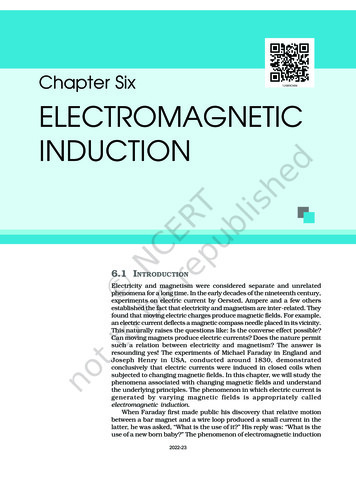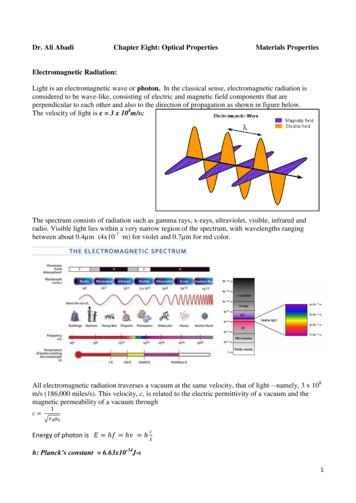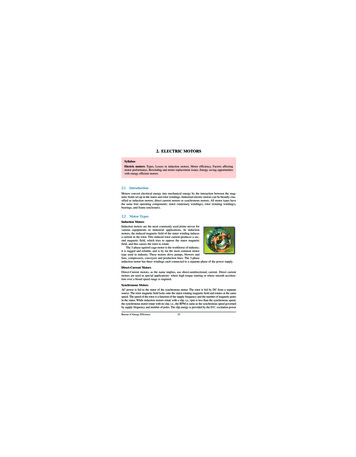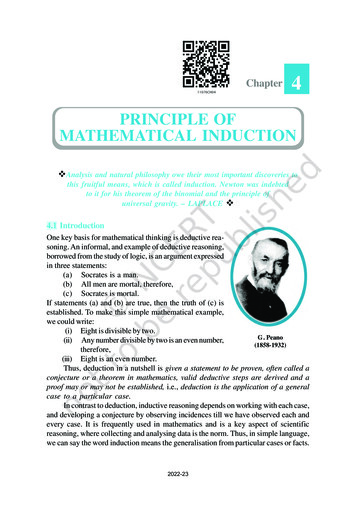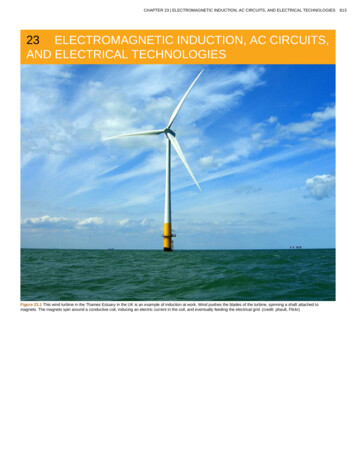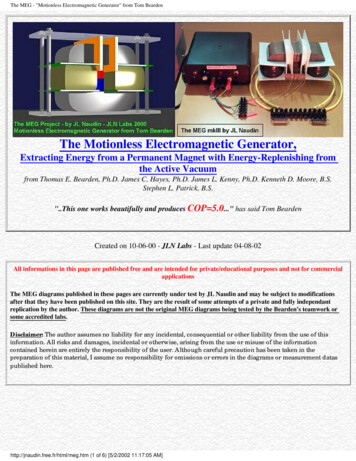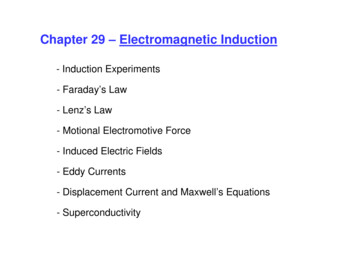
Transcription
Chapter 29 – Electromagnetic Induction- Induction Experiments- Faraday’s Law- Lenz’s Law- Motional Electromotive Force- Induced Electric Fields- Eddy Currents- Displacement Current and Maxwell’s Equations- Superconductivity
- If the magnetic flux through a circuit changes, an emf and a current areinduced.- A time-varying magnetic field can act as source of electric field.Maxwell- A time-varying electric field can act as source of magnetic field.1. Induction Experiments (Faraday / Henry)- An induced current (and emf) is generated when: (a) we move a magnetaround a coil, (b) move a second coil toward/away another coil, (c) changethe current in the second coil by opening/closing a switch.
- Magnetically induced emfs are always the result of the action of nonelectrostatic forces. The electric fields caused by those forces are En (nonCoulomb, non conservative).2. Faraday’s LawMagnetic flux: Φ B B dA B cos ϕ dA If B is uniform over a flat area A: Φ B B A B A cos ϕ
Faraday’s Law of Induction:- The induced emf in a closed loop equals the negative of the time rate ofchange of the magnetic flux through the loop.dΦ Bε dt- Increasing flux ε 0 ;- Direction: curl fingers ofright hand around A, if ε 0is in same direction of fingers(counter-clockwise), if ε 0contrary direction(clockwise).- Only a change in the fluxthrough a circuit (not fluxitself) can induce emf. If fluxis constant no inducedemf.Decreasing flux ε 0
Coil:ε NdΦ BdtN number of turns- If the loop is a conductor, an induced current results from emf. This currentproduces an additional magnetic field through loop. From right hand rule,that field is opposite in direction to the increasing field produced byelectromagnet.Ex: 29.4 - Generator I: a simple alternator
Exs: 29.6, 29.7 - Generator III: the slide wire generator
3. Lenz’s Law- Alternative method for determining the direction of induced current or emf.The direction of any magnetic induction effect is such as to oppose thecause of the effect.-The “cause” can be changing the flux through a stationary circuit due tovarying B, changing flux due to motion of conductors, or both.
- If the flux in an stationary circuit changes, the induced current sets up amagnetic field opposite to the original field if original B increases, but in thesame direction as original B if B decreases.- The induced current opposes the change in the flux through a circuit (notthe flux itself).- If the change in flux is due to the motion of a conductor, the direction of theinduced current in the moving conductor is such that the direction of themagnetic force on the conductor is opposite in direction to its motion (e.g.slide-wire generator). The induced current tries to preserve the “status quo”by opposing motion or a change of flux.B induced downward opposing the changein flux (dΦ/dt). This leads to induced currentclockwise.
Lenz’s Law and the Response to Flux Changes- Lenz’s Law gives only the direction of an induced current. The magnitudedepends on the circuit’s resistance. Large R small induced I easier tochange flux through circuit.- If loop is a good conductor I induced present as long as magnet moveswith respect to loop. When relative motion stops I 0 quickly (due tocircuit’s resistance).- If R 0 (superconductor) I induced (persistent current) flows even afterinduced emf has disappeared (after magnet stopped moving relative to loop).The flux through loop is the same as before the magnet started to move flux through loop of R 0 does not change.
Magnetic levitation:-The principle of levitation is Lenz' rule.1) The magnetic field created by the induced current in a metallic sampledue to time-fluctuation of the external magnetic field of the coil wants toavoid its cause (i.e., the coil's fluctuating magnetic field).2) Thus, the induced magnetic field in the sample and the external fluctuatingmagnetic field of the coil repel each other.3) The induced magnetic field (and the sample) move away from its cause,i.e. away from the coil's magnetic field. Then, for a conical coil (smallerradius at the bottom than at the top) the metallic sample will move upwarddue to this levitation force, until the force of gravity balances the force oflevitation. (The levitation force is larger at the bottom of the conical coil thanat the top of the coil).
Induced Current / Eddy current levitation:-The rail and the train exert magnetic fieldsand the train is levitated by repulsive forcesbetween these magnetic fields.-B in the train is created by electromagnetsor permanent magnets, while the repulsiveforce in the track is created by a induced magnetic field in conductorswithin the tracks.-Problems:(1) at slow speeds the current induced in the coils of the track’sconductors and resultant magnetic flux is not large enough to supportthe weight of the train. Due to this, the train needs wheels (or anylanding gear) to support itself until it reaches a speed that can sustainlevitation.(2) this repulsive system creates a field in the track (in front and behindthe lift magnets) which act against the magnets and creates a “dragforce”. This is normally only a problem at low speed.
4. Motional Electromotive Force- A charged particlea in rod experiencesmagnetic force F qv B that causesfree charges in rod to move, creating excesscharges at opposite ends.- The excess charges generate an electricfield (from a to b) and electric force (F q E)opposite to magnetic force.- Charge continues accumulating until FEcompensates FB and charges are inequilibrium q E q v BVab E L v B L- If rod slides along stationary U-shapedconductor no FB acts on charges in Ushaped conductor, but excess charge atends of straight rod redistributes along Uconductor, creating an electric field.
-The electric field in stationary U-shaped conductor creates a current moving rod became a source of emf (motional electromotive force). Withinstraight rod charges move from lower to higher potential, and in the rest ofcircuit from higher to lower potential.ε vBLInduced current:Length of rod and velocity perpendicular to B.εvBLI RR- The emf associated with the moving rod is equivalent to that of abattery with positive terminal at a and negative at b.Motional emf: general form (alternative expression of Faraday’s law) dε ( v B ) dl ε ( v B ) dlClosed conducting loop-This expression can only be used for problems involving moving conductors.When we have stationary conductors in changing magnetic fields, we need touse: ε -dΦB/dt.
5. Induced Electric Fields- An induced emf occurs when there is achanging magnetic flux through a stationaryconductor.- A current (I) in solenoid sets up B along itsaxis, the magnetic flux is:Φ B B A µ 0 nIAε dΦ BdI µ 0 nAdtdtInduced current in loop (I’): I’ ε / R- The force that makes the charges movearound the loop is not a magnetic force. Thereis an induced electric field in the conductorcaused by a changing magnetic flux.
-The total work done on q by the induced E when it goes once around theloop: W q ε E is not conservative. Conservative E E dl 0 dΦ B (stationary integration path)Non-conservative E E dl ε dt- Cylindrical symmetry E magnitude constant, direction is tangent to loop. E dl 2π r EE 1 dΦ B2πr dt- Faraday’s law: 1) an emf is induced by magnetic forces on charges whena conductor moves through B.2) a time-varying B induces E in stationary conductorand emf. E is induced even when there is no conductor.Induced E is non-conservative, “non-electrostatic”. Nopotential energy associated, but FE q E.
6. Eddy Currents- Induced currents that circulate throughout thevolume of a material.Ex.: B confined to a small region of rotatingdisk Ob moves across B and emf is induced induced circulation of eddy currents.Sectors Oa and Oc are not in B, but provide returnconducting paths for charges displaced along Ob toreturn from b to O.Induced I experiences FB that opposes disk rotation: F IL B (right) current and L downward.(the return currents lie outside B do notexperience FB).-The interaction between eddy currents and B causesbraking of disk.
(a) Metal detector (airport security checkpoint) generates an alternating B0that induces eddy currents in conducting object (suitcase). These currentsproduce alternating B’ that induces current in detector’s receiver (I’).(b) Same principle as (a).
7. Displacement Current and Maxwell’s Equations- A varying electric field gives rise to a magnetic field.Ampere’s Law B dl µ0 I encl(incomplete)Charging a capacitor: conducting wires carry iC (conduction current) intoone plate and out of the other, Q and E between plates increase. B dl µ0iCbut also 0 for surface bulging outContradiction?As capacitor charges, E and ΦE throughsurface increase. ε A q C v ( E d ) ε E A ε Φ E d iC dqdΦ E εdtdt
Displacement current (iD): fictitious current in region between capacitor’splates.iD εdΦ EdtChanging the flux through curved surface is equivalent in Ampere’s law toa conduction current through that surface (iD)Generalized Ampere’s Law: B dl µ0 ( I C I D )enclValid for any surface we use: for curvedsurface ic 0, for flat surface iD 0.ic (flat surface) iD (curved surface)Displacement current density (jD):iDdEjD εAdtThe displacement current is the source of B in betweencapacitor’s plates. It helps us to satisfy Kirchoff’s junction’s rule: IC in and ID out
The reality of Displacement Current- Displacement current creates B between platesof capacitor while it charges.(r R) B dl 2π r B µ0 I encl µ0 jD A22rr iD 2 µ0 (π r) µ 0 2 iD µ 0 2 iC 2RR π R µ0 rB i2 C2π R- In between the plates of the capacitor: (r R) B 0 at r 0 (axis) andincreases linearly with distance from axis.- For r R B is same as though the wire were continuous and plates notpresent.
Maxwell’s Equations of Electromagnetism Qencl E dA Gauss Law for E B dA 0Gauss Law for Bε0 dΦ E B dl µ0 iC ε 0 dt encl dΦ B E dl dt E Ec E n(there are no magnetic monopoles)Ampere’s lawFaraday’s lawTotal electric field E caused by a distribution of chargesat rest (Ec electrostatic) E magnetically induced (En,non-electrostatic).
Symmetry in Maxwell’s EquationsIn empty space ic 0, Qencl 0 d B dl ε o µ0 dt E dA d E dl dt B dA F q( E v B) Φ E E dA Φ B B dA
8. SuperconductivityHg- Sudden disappearanceof R when material cooledbelow critical T (Tc).- For superconductingmaterials Tc changes whenmaterial under external B0.- With increasing B0, superconducting transitionoccurs at lower and lower T.- Critical field (Bc): minimum B required to eliminateSC at T Tc.The Meissner effect- SC sphere in B0 at T Tc normal phase (not SC)- If T Tc and B0 not large enough to prevent SCtransition distortion of field lines, no lines insidematerial.
- If coil wrapped around sphere emf induced in coil shows that duringSC transition the magnetic flux through coil decreases (to zero).- If B0 turned off while material still in SC phase no emf induced in coiland no B outside sphere.- During SC transition in the presence of B0, all magnetic flux is expelledfrom the bulk of the sphere and the magnetic flux through a coil is zero.The “expulsion” of B is the “Meissner effect”. That results in an increasedB (more densely packed field lines) close to the sides of the sphere.
http://www.youtube.com/watch?v G3eI4SVDyME(11:11) Emf Induction while moving a bar magnet over a conducting loophttp://www.youtube.com/watch?v qxuGDEz8wDg&NR 1(10:35), (17:10)Emf induction while changing the angle phi in a loop(38:28) Eddy currents
free charges in rod to move, creating excess charges at opposite ends. - The excess charges generate an electric field (from a to b) and electric force (F q E) opposite to magnetic force. - Charge continues accumulating until F E compensates F B and charges are in equilibr


